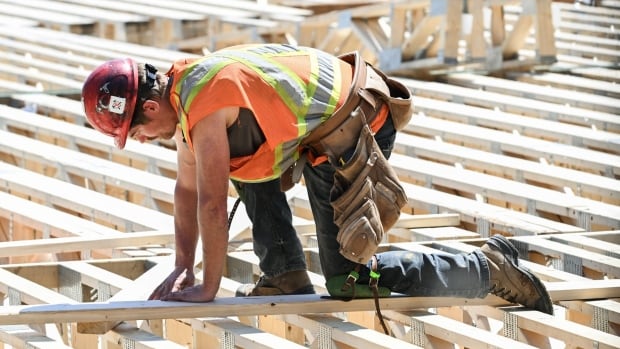The federal government’s decision to eliminate the GST on purpose-built rentals is expected to add tens of thousands of units to the housing market. But it’s just the first step needed if Canada wants to actually close the housing gap.
Prime Minister Justin Trudeau this week announced the move to waive the federal portion of the HST on the construction of rental housing.
Mike Moffatt, senior director of policy and innovation at the Smart Prosperity Institute in Ottawa, is still trying to figure out precisely how the elimination of the tax will impact supply. But he crunched the numbers after the federal announcement and says some back-of-the-envelope calculations are encouraging.
“I think this could increase supply by 200,000 to 300,000 by end of 2030, but that was a really rough estimate,” he told CBC News.
That’s encouraging, but industry players say governments at all levels must do more — much more — to build enough housing in this country. The Canada Mortgage and Housing Corporation (CMHC) says 3.5 million new homes are needed by the end of 2030.
That would require Canada to build at a faster rate than this country has seen in decades. But there are some simple steps that can help move things along.
Speed up approvals process
“I always look at it in three buckets: You need the approvals, you need the people to build these things and you need a way to finance it,” said Ana Bailão, the former deputy mayor of Toronto and housing advocate.
“Right now, we’re having issues in all three buckets,” she said.
Bailão says all levels of government need to step up and make changes. But with the stroke of a pen, she says, cities can dramatically speed up the approvals process.
The City of Toronto has started making some changes to its zoning regulations, but people like Bailão are pushing the city to go much further in its next phase, which is still being considered.
The concept she’s calling for is called “upzoning.” It would match local zoning with the city’s plan to increase density in specific areas.
“Right now, you have to go through a rezoning process, which takes a minimum of a year if not more — even though we’ve agreed we want density on those streets,” Bailão said.
And that doesn’t just mean new condo towers. Density comes in all shapes and sizes.

In Vancouver, sweeping changes have just been approved to allow and encourage the building of multiplexes.
“Most of Vancouver’s land is residentially zoned,” said Steve Saretsky, a real estate broker and researcher in the Lower Mainland. So until this week, he says, the only thing you could build without a zoning change was a single-family home or a duplex.
But now, the city will allow multiplexes of up to six units on residential lots. Developers can build as many as eight units if they are purpose-built rentals and one of the units is occupied by the registered owner of the site.
“Multiplexes are definitely needed,” Saretsky said. “There is going to be a lot more demand from families for multiplex units than there is going to be for a 40-storey highrise.”
More construction workers needed
But zoning can only encourage so much. In order to get things built, Canadian developers need labour.
When he was sworn in as the new federal housing minister in July, Sean Fraser — who previously served as immigration minister — drew a straight line between the housing crisis and a shortage of skilled trades workers.
“When I talked to developers in my capacity as a minister of immigration before today, one of the chief obstacles to completing the projects that they want to get done is having access to the labour force to build the houses that they need,” he said.
Featured VideoJennifer Keesmaat, the former chief planner for the City of Toronto, explains how the federal government’s decision to remove the GST on purpose-built rentals can help alleviate the housing shortage across the country by encouraging developers to build rental units quickly.
There are tens of thousands of unfilled construction jobs across Canada, according to the Labourers’ International Union of North America.
Economists have long argued that the federal government needs to adjust its immigration targets to bring in more electricians and plumbers.
Even if the regulatory process is addressed and developers have the right balance of workers, one developer says new units just won’t get built if the money doesn’t add up.
Lower interest rates for financing
Jennifer Keesmaat, a partner at Markee Developments and the former chief planner in Toronto, is trying to build 10,000 new units in the next 10 years. But she says her company faces obstacles at every turn.
Keesmaat says rising interest rates have pushed many development projects out of viability. She says the elimination of the GST will help shift some back into operation and that speeding up the approvals process will help others.
Markee is developing a 23-hectare site that will include 1,500 units and 12 buildings. But Keesmaat says it took a year to get a hearing after a neighbour filed a complaint about the zoning process. That complaint was eventually dropped, but in the interim, interest rates had gone up 10 times.
CMHC has a funding program called the Rental Construction Financing Initiative (RCFI), which is aimed at encouraging developers to build more affordable rental accommodation.

“RCFI no longer works because the interest rates are too high,” Keesmaat said. “The government could very quickly act to lower the rate of borrowing through RCFI for new construction projects.”She says that would tip some development projects back into viability.
None of these proposals are new, and politicians at all levels have heard them for years. In the case of the federal decision to eliminate the GST, the idea has been bounced around for more than a decade.
But Bailão, Toronto’s housing advocate, says something has changed in the past few months.
“There’s been a huge shift, and I think it’s because people are feeling [the housing crisis],” she said.
The housing crisis has reached a new level, and just about everyone knows someone who is struggling to find an affordable place to live, she says. That in turn has put pressure on politicians to take action.
The key, Bailão says, is making that pressure stick, so the elimination of the GST is just the beginning of broader changes to address the crisis in a meaningful way.









